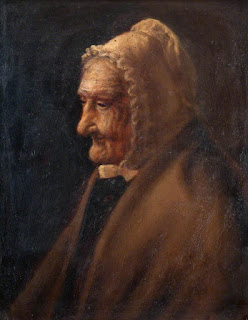Health Nonsense, Celebrity Nonsense, Burberry Hanging
Health Craze in USA
 |
Portait of an Old Woman, unknown artist
Photo Credit: South Lanarkshire Council [CC BY-NC-ND]
|
Some
clinics across the country claim that these plasma transfusions can treat
memory loss, tackle dementia, Parkinson’s disease, heart disease and even help
people with post-traumatic stress disorder.
The
cost? Ambrosia Medical, in San Francisco, offered transfusions of 1 litre of
plasma for $8,000.
However,
there is almost no scientific evidence to suggest the procedure works in
humans. In 2017, a clinical trial found that transfusions of young blood to 18
patients with Alzheimer’s did nothing to treat the disease.
Scott
Gottlieb, the Commissioner of the Food and Drug Administration, and Peter
Marks, the director of the FDA’s centre for biologics evaluation and research
said in a statement:
“Simply
put, we’re concerned that some patients are being preyed upon by unscrupulous
actors touting treatments of plasma from young donors as cures and
remedies…Such treatments have no proven clinical benefits for the uses for
which these clinics are advertising them and are potentially harmful.”
(The
Times, 2019)
Any celebrity endorsement yet?
Bodies
 |
| Vanity Fair, James Elder Christie (1847-1914) Photo Credit: Glasgow Museums [CC BY-NC-ND] |
… The YouTube
star, Anastasiya Shpagina from Odessa, who drew 5 million viewers to her
instructional video on how to look like Miley Cyrus and Kandee Johnson from Los
Angeles, whose human transformation into a Barbie has had some 33 million
viewers, meticulously demonstrates how to change your look. Justin, another
YouTuber, has undergone 125 procedures and spent $158,000 to make himself
resemble Ken by transforming his torso, face, biceps, triceps and hairline;
over 16 million people have seen his video.
… Bodies are made. They are no longer seen or experienced simply as things to be washed, deodorised, dressed and perfumed before getting on with our day. Bodies are now our ever- malleable calling cards, either erasing or articulating our class, geographic and ethnic backgrounds and gender aspirations. Appearance is crucial and the look, once achieved, has to be endlessly shared and approved through selfies and sexting. Teenage girls sculpt their appearance to garner “likes” and approval, which sadly, they rarely achieve. Research done for Dove showed that it takes 124 likes to feel OK but most tend to receive under a fifth of that number, not because they aren’t likeable but because everyone is chasing a like, and time is against them.
Living online, seeking recognition online, living through identification and wanting to emulate celebrities such as Kim Kardashian are now commonplace for girls and young women…
… Meanwhile, highly profitable industries wage war on us, including the cosmetic, fashion, style, food, diet, health, anti-ageing, wellness, surgical, pharmaceutical and fitness industries, as they promote the body beautiful…
(Susie Orbach, The Guardian, 2019)
Burberry
… Bodies are made. They are no longer seen or experienced simply as things to be washed, deodorised, dressed and perfumed before getting on with our day. Bodies are now our ever- malleable calling cards, either erasing or articulating our class, geographic and ethnic backgrounds and gender aspirations. Appearance is crucial and the look, once achieved, has to be endlessly shared and approved through selfies and sexting. Teenage girls sculpt their appearance to garner “likes” and approval, which sadly, they rarely achieve. Research done for Dove showed that it takes 124 likes to feel OK but most tend to receive under a fifth of that number, not because they aren’t likeable but because everyone is chasing a like, and time is against them.
Living online, seeking recognition online, living through identification and wanting to emulate celebrities such as Kim Kardashian are now commonplace for girls and young women…
… Meanwhile, highly profitable industries wage war on us, including the cosmetic, fashion, style, food, diet, health, anti-ageing, wellness, surgical, pharmaceutical and fitness industries, as they promote the body beautiful…
(Susie Orbach, The Guardian, 2019)
What a sad article and what springs to mind is to ask how
many young people in the UK want to emulate these online “celebrities”? How
prevalent is this? How many actually believe appearance is crucial? Of course,
millions will view these videos on how to change their looks but how many do
this for a laugh, or out of interest and curiosity rather than having a
definite commitment to changing how they look? How commonplace is commonplace?
Burberry
Burberry has apologised for including a garment with a noose
around the neck at the London Fashion Week Show.
Writing on social media, Liz Kennedy, a model
who walked in the Burberry show said she was, “ashamed to have been a part of
the show. Suicide is not fashion. It is not glamorous or edgy.”
She went on to claim that in the dressing room models and
stylists were joking about the noose and hanging it from the ceiling as they
attempted to tie the knot. Burberry has removed the item from its collection.
Marco Gobbetti, Burberry’s chief executive said:
“Though the design was inspired by the marine theme that ran
throughout the collection, it was insensitive and we made a mistake.”
(The Times, 2019)
Didn’t the company also make a mistake in 2017 by destroying unsold
clothes, accessories and perfume worth over £28 million in order to protect the
brand?
Comments
Post a Comment